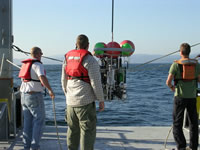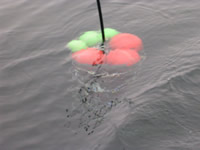


|
The Project
|
August 21, 2005
Buoyancy/Neither Floating nor Sinking Today at dawn the ship’s foghorn blew, one long blast and two short blasts, a signal for low visibility, sounded to warn other boats of the ship’s location. The ship sounded this warning signal once every five minutes for about three hours until visibility improved. Buoyancy was the word that was most often spoken by the science team on the New Horizon during the past twenty-four hours. An object that is neutrally buoyant in water will neither float on top of the water nor will it sink rapidly to the bottom. The science goal was to get the SLOWDROP profiler, with all its sensors, pumps, and electrical connectors, to become almost neutrally buoyant in the salt water of the Monterey Bay. The team needed to adjust the buoyancy so that the profiler sinks at a slow speed. Hard plastic floats were roped tightly to the profiler to add floatation. The float test was then conducted by notifying the captain or mate on duty, releasing the support straps that hold the profiler to the deck, securing safety or ‘tag’ lines to the profiler, releasing some cable from roll of cable that sits on the deck, and finally lowering the profiler into the water off the back of the ship. When the profiler was in the water and the cable was loose, everyone looked over the back end of the ship to see if the profiler floated or sank. The profiler proved to be unsinkable during several attempts. Every time the profiler floated during a test, it was retrieved from the water, adjustments were made using different floats and weights, and the entire process was repeated. The team worked on this task for at least 6 hours before everyone cheered as the profiler sank below the water surface at the proper speed of about 0.15 meters per second. Several more sink tests were conducted as all the instruments were monitored on computers within the lab. Now, with everything running smoothly, the profiler will be released several times per day in different areas of the research site. Here is an experiment you can do with buoyancy: Find a small plastic container (with a handle if possible. A syrup jug works well) Tie a string or a rope on the plastic container. Check to see if the container floats and is watertight. The container floats because air is less dense then the water. Experiment with adding weight until the container sinks under the surface of the water but not to the bottom. When this happens the weights balance the buoyancy of the air in the container and the package is neutrally buoyant. This experiment can be changed by starting with an object that sinks (just like the team’s profiler of sensors). This time floats or weights are added until it sinks very slowly. You will find that this is very challenging but it is fun to achieve success. If you have a deep enough pool or tank you can use a stopwatch to time the sinking speed of descent. If you are working with a group, have a contest to see whose object falls the slowest through the water.
|



